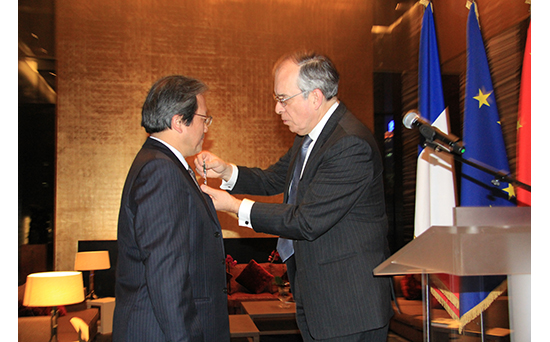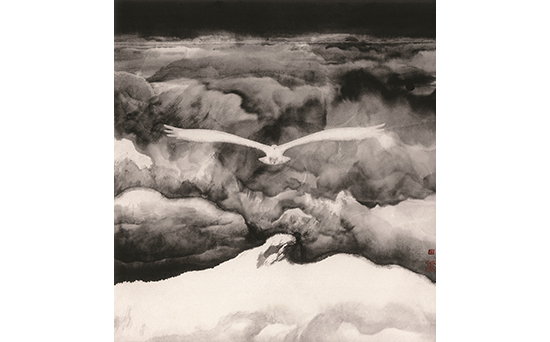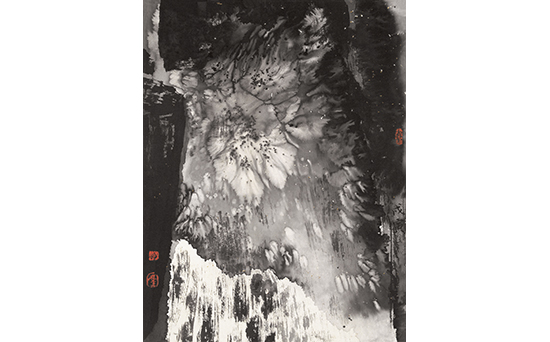

Art and Exchange of Heart
——Interview with Feng Yuan, Vice President of CFLAC and CCICH

H.E. Mr. Maurice Gourdault-Montagne, the French ambassador awarded Mr. Feng Yuan with a medal on behalf of the French government.

A Spiritual Getaway by Feng Yuan

RunXia (or Moist Bottom) in the Abstract Water and Ink Series by Feng Yuan
“Mr. Feng Yuan is not only an artist and educationist, but also a cultural envoy who has significantly promoted cultural exchange and development between China and France.” Maurice Gourdault-Montagne, French Ambassador to China, commented at the award ceremony at the embassy on behalf of French government lately. When conferring the Order of Chivalry in Arts and Literature to Feng Yuan, vice president of CFLAC and China Central Institute for Culture and History (CCICH), the ambassador spoke highly of Feng’s artistic achievement by briefing his art experience in France and his contribution to the advancement of cultural exchange between China and France.
Established by French Ministry of Culture and Communication in 1957, the Order of Chivalry in Arts and Literature, as the supreme honor given by French government to the literary and art circles, is awarded to those French and foreigners who have made a special achievement and outstanding contribution in promoting French and global cultures. As a well-known painter, Feng Yuan is so perseverant in his artistic practice that he has created a series of masterpieces of extensive influence, and in the meanwhile, he has participated in and organized large-scale cultural exchange events on many occasions, both of which are commonly recognized and appreciated in literary and art circles.
Magic Rendez-vous with French Arts Changed his Life
To Feng Yuan, his French Order of Chivalry in Arts and Literature is a surprise as well as an honor because it signifies recognition from the French government and colleagues in arts. “I am fully aware of this significance in two levels. One is that I have obtained something in artistic creation, and the other indicates that I have done my part in promoting Chinese cultural exchange with foreign countries.” Feng Yuan said. As far as he is concerned, China and France are both blessed with a long history and a splendid civilization. Though apart from each other by remote distance, they enjoy a time-honored friendship and have respectively made a crucial contribution to human civilization in their own cultural and historic progress. With mutual respect and appreciation, both countries can learn from each other and gain a reciprocal development by means of cultural exchange and cooperation. “This honor will help me to continue my job in promoting cultural exchange in future.” Feng Yuan added.
In Chinese people’s opinion, one is destined for somethings, and it is the case for Feng Yuan and France. During the transition from spring to summer in 1978, Feng Yuan left Northeast China on business for Shanghai to inspect an exhibition of French Rural Landscape Paintings in the 19th Century that his fellows would visit sometime later. As it was the first French Art Collections exhibition since China’s reform and opening up, Feng Yuan was able to witness those classic masterpieces in such a short distance. It was at this exhibition that Feng Yuan encountered Mr. Ren Bohong, an editor from Shanghai People’s Fine Arts Publishing House, who later introduced Mr. Fang Zengxian to him as well.
Fang Zengxian was a modest man and extended his personal invitation to Feng Yuan at greetings and shaking hands. At that time, Fang Zengxian was a prestigious portrait painter and professor of Zhejiang Academy of Fine Arts. As a newcomer in fine arts, Feng Yuan was so eager to obtain instruction from such a master that he soon visited Fang’s house with his own sketches and paintings. After viewing his works, Prof. Fang found Feng Yuan to be a promising talent and therefore suggested that Feng Yuan sit for national examination for academy and college. He even encouraged Feng Yuan to apply for master degree under his instruction. However, it was the beginning year of post-graduate study after a decade’s suspension and the preliminary examination had been over. Feng Yuan never expected any of these, but Prof. Fang insisted in his recommendation to the academy. Afterwards, thanks to the support and endeavor of Prof. Fang and other people, Feng Yuan finally managed to take a make-up exam for a master in the figure painting class of traditional Chinese painting and then entered the final selection. That December, he was admitted as a post-graduate student of Zhejiang Academy of Fine Arts, which was the good beginning of his teaching, creation and research of fine arts in life.
In a word, it was the 19th Century French Rural Landscape Paintings Exhibition that brought Feng Yuan a good opportunity to associate with his tutor and changed his own life.
Creation in Deep Influence of Learning and Exchange in France
From the end of the 19th century till the 20th century, France was the core center of arts in Europe and even the world, where a great quantity of outstanding Chinese artists had learning, research and creation experience in arts such as Xu Beihong, Lin Fengmian and Wu Guanzhong. As outstanding artists, they not only learned oil painting in Europe in their early life, but also combined traditional Chinese water-ink painting and Western painting art together. Lin Fengmian introduced colors of Impressionism to Chinese Xuan paper and colorful ink while Wu Guanzhong made a successful integration of French expressions of Classicism and Romanticism with Chinese water-ink painting, both of which gave an important advancement to the contemporary innovation in Chinese arts.
Moreover, with precious experience of learning and research in France, many predecessors such as Xu Beihong and Lin Fengmian brought the successful practice of European art education back to China and fostered a large number of talents in fine arts, which served as a significant contribution to promoting Chinese fine arts cause and fine arts educational cause. For Chinese young painters, it was such a joyful and ambitious task to further learning of arts in France, and Feng Yuan was no exception. In 1998, Feng Yuan came to France for the first time since many art academies in China managed to set up the first studio in the International City of Arts in Paris so that a group of teachers could complete their study and exchange every three months. This studio provided Chinese artists with convenient conditions to know more about French arts as well as European arts. During his stay in France, Feng Yuan visited the Louvre, Musée d’Orsay, Palace of Versailles, Pompidou Center and the main museum of Impressionism with a careful inspection. Then he traveled to Spain and Italy where he visited almost all the main museums of Europe and appreciated a batch of classic artworks in a collective way. In the meanwhile, he associated with a group of French artists and overseas Chinese artists in France.
During his stay in France, Feng Yuan imbued his insigh, feelings and learning from his visit into his creation and brought about a series of works. All those works embodied Western expressionism and contemporary painting concepts and demonstrated a certain difference from traditional Chinese painting in the ways of expression. At the end of his 3-month study in France, Feng Yuan presented all his works created in France within a personal exhibition in the studio, which received attention from many French artists and overseas Chinese artists in France. After viewing his abstract water-ink paintings and portraits, all his counterparts in France realized that this Chinese artist had systematic training and solid foundation and that he not only had his unique art language of Orient, but also did well in absorbing Western art concept and technique. As a result, many of them became greatly interested in traditional Chinese paintings of ink and brush.
Certainly, three months were still too short. As his position required, Feng Yuan was unable to accomplish a complete study abroad as his predecessorsdid, but he benefited a lot from this precious experience. “In retrospect of my 3-month study in France, while mastering traditional art expression technique, I have become far more tolerant with concept of artistic creation, variety of expressions and even absorbing nutrition from Western painting than my predecessors. Probably, it is the most significant influence from my French counterpart as well as the main reason why they could appreciate my artworks.” Feng Yuan concluded.
As far as Feng Yuan can see, we are currently in an age where different nationalities and cultures will collide, exchange and influence with each other. In the course of mutual respect, learning and appreciation, artists will absorb the subtle interaction between varied cultures into their own artistic creation so as to enrich their own artistic styles. As a beneficiary of cultural exchange between China and the world, Feng Yuan has witnessed his own change in his practice of artistic creation arising from his short visit to France.
“French Impressionist Paintings” Set a Record of Visit of NAMOC
The Cultural Years of China and France, under the auspice of national leaders of the People’s Republic of China and the Republic of France and thanks to common promotion of cultural envoys and artists of the two countries, exerted an extensive impact as a cultural exchange event. In corporation with Musée d’Orsay of France, Feng Yuan, then president of National Art Museum of China (NAMOC), made “French Impressionist Precious Paintings Exhibition” possible in NAMOC in Beijing starting from October of 2004, which constituted the main part of the Cultural Year of France in China.
This exhibition became the most representative, the largest-scale and an all-round exhibition of Impressionist artists in China ever since the birth of French Impressionism. In great expectation by the Chinese artists, this art exhibition aroused an unprecedented feedback in Beijing.
The Impressionist painting contitutes a development of European traditional art style, an extension of experimental innovation in realistic visual arts as well as the ultimate outcome of “restoring” class painting evolution since the Renaissance. Chinese artists and audiences had heard a lot about those representative French Impressionist painters and their works, but they still did not manage to observe the real paintings in their eyes. “It had been my idea to introduce some representative works of French Impressionist painters to Chinese audiences. The French counterpart showed a great support by designating Musée d’Orsay to cooperate with us on this project.” Feng Yuan said.
For this event, Musée d’Orsay provided 51 magnificent representative artworks by such Impressionists as Manet, Monet, Renoir, Degas and Cézanne to showcase the initial birth, development, disciplinary value and academic outcome of Impressionism. As the representative figures of Impressionist painting, while preserving the classical format and core aesthetic concept of painting, they emphasized on depicting the instantly visual sense, attempted to establish a different visual structure from that in Classicism or Academic Arts, and endeavored to reach a comprehensive and highly rational summary of the visible objects.
As a way to promote mutual knowledge and friendship between China and France, this exhibition became a timely opportunity for Chinese art amateurs who could gain a profound understanding and appreciation of the technique, style, ingenious creation and ideals hidden in those artworks. Nevertheless, the amount of Chinese audiences and visitors from neighboring countries were far beyond expectation. Every day, NAMOC was crowded with so many people. Since excessive audiences’ breath and movement would lead to great humidity that would harm the precious masterpieces, NAMOC was obliged to limit the flow of audiences by making reservations. The exhibition was extented for another ten days and a special evening show was added daily. Within a month, the total of audiences reached 390000 and set a record of visitors in the history of NAMOC.
Culture: a Window to Feel, Know and Understand China
For years Feng Yuan has made enormous efforts in strengthening Chinese cultural exchange with foreign counterpart. Some of his works including Centennial Sage and Mother and Son have been exhibited at different times all over the world. As Feng Yuan put, art is a carrier of emotion and culture is a heart-to-heart bridge. As an important bond of people’s friendly communications between China and the rest of the world, cultural exchange has been playing an indispensible role in bettering mutual understanding and friendship among the peoples of different countries.
As Feng Yuan holds, literary and artistic creation, as the human’s most profound and mysterious way of expression, has surpassed limitation of time and space and cultural differences. In his opinion, a genuine art is always a lively expression of human emotion, thinking and faith and can be constantly endowed with new connotation. As culture signifies the creativity and innovation level of a nation, cultural exchange and exhibition between each other is the best way to deepen mutual understanding and fraternity between the peoples of varied nations and nationalities. “Sometimes, interpretation is unnecessary. A beautiful painting, a graceful gesture of dance or a pleasant melody will directly help people fulfill the understanding of beauty. Only when people are closer at heart for further understanding will cultural dissemination be most effective.” Feng Yuan said.
Indeed Feng Yuan has given a careful thought to how to promote Chinese culture abroad and how to strengthen China’s cultural exchange with the outside world. According to him, culture is a significant component of national comprehensive power and has become increasingly outstanding in both status and function among the competition of national comprehensive power, as currently the global competition has evolved into that in culture. Therefore, how to prosper China’s literary and art cause, how to build up “national image” in varied arts so as to upgrade the “soft power” and international influence will always be the key issue for us to address in the current reality. To Feng Yuan’s joy, along with the increasing cultural exchange events, Chinese culture is showcasing the latest achievement of Chinese literature and arts through varied channels, demonstrating a brand new outlook of today’s China—openness, development and progress, and providing the world with a window to feel, know and understand China.
